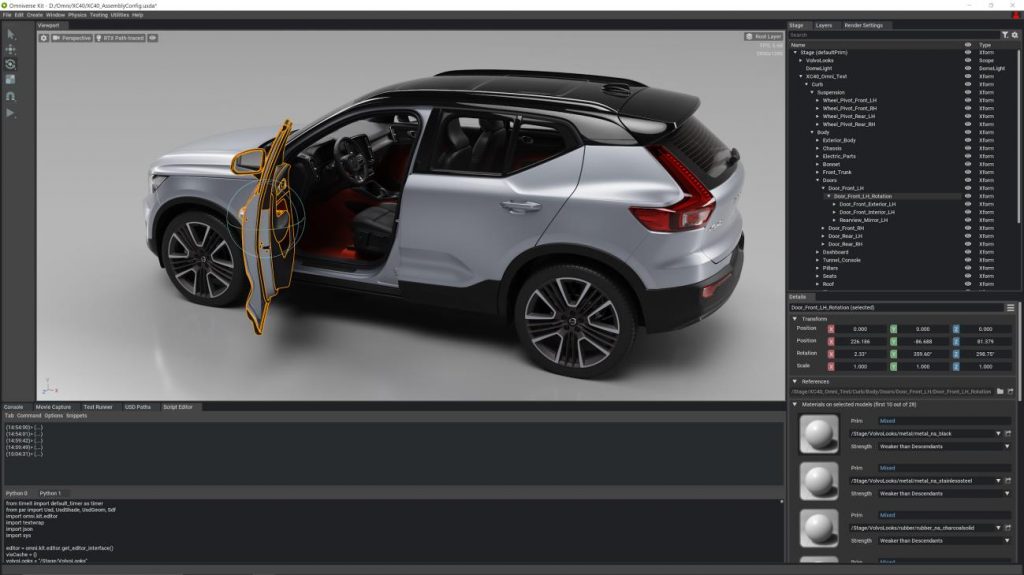Nvidia is forging ahead with its Omniverse collaboration platform. Today it unveiled a specific variant for the Architecture Engineering and Construction (AEC) sector and shared plans to focus on manufacturing later this year.
Nvidia Omniverse essentially allows teams to work together, interactively using their 3D design tools of choice.
Data from multiple applications can be seamlessly streamed into the Omniverse and the resulting asset, be it a building, product or VFX scene, can be interacted with live in a real-time, ray-traced viewport accelerated by Nvidia Quadro RTX GPUs.
“Multiple designers can work on one design at the same time and reviewers can ask for changes in real time,” explains Nvidia CEO Jensen Huang.
While the major focus is currently on AEC, Volvo Cars has been testing Omniverse in its research and development workflows, “We immediately saw the opportunity for real-time collaboration for our design workflow using Omniverse,” said Mattias Wikenmalm, senior visualisation expert at Volvo Cars. “It’s something we have been striving for throughout our efforts to optimise our design and development process.”
Omniverse is an evolution of Holodeck, an experimental technology that used virtual environments for collaborative workflows. But whereas Holodeck was all about VR, Omniverse is a much broader collaboration platform. Richard Kerris, Industry GM for M&E at Nvidia describes it as “Google Docs for your world.”.
The platform relies on the USD (Universal Scene Description), an open framework for the interchange of 3D computer graphics data, specifically focused on collaboration.
“It standardises toolsets and environments and models and all of the things that go into creating an object or an environment,” said Kerris.
USD was originally designed for visual effects and animation, but it immediately started to gain traction in other industries.
It provided a means of transferring files without importing or exporting, but having it happen live between applications.
Kerris is keen to point out that Nvidia is not looking to make a product out of Omniverse. He explains that one of the guiding principles is for Independent Software Vendors (ISVs) to add, embellish and do whatever they want to do with it as a platform.
Nvidia has been working closely with Autodesk, McNeel, Trimble and Epic Games but is also talking to others. An SDK, Omniverse Kit, is available to help ISVs gives their products a real-time, ray-traced application viewport.
Omniverse can run on a Quadro RTX desktop or mobile workstation allowing users to get an interactive viewport into the shared scene. However, the real power of the platform comes into play when using Nvidia RTX Server, a reference design available for a range of OEMs with up to eight or ten Nvidia Quadro RTX 6000 or 8000 GPUs.
RTX Server can perform multiple roles. It not only provides buckets of processing power for real time ray tracing, but with Nvidia Quadro Virtual Data Center Workstation (Quadro vDWS) software users can access the Omniverse platform using GPU-accelerated virtual machines.
It means all collaborators, including clients, can view projects in full interactive ray traced quality on low powered hardware – laptop, tablet or phone. Firms can also run their 3D design tools directly off RTX Server.
Omniverse is not just for static displays – XR has a massive role to play. For example, an iPad can be used to window into an AR-based view of the building that’s sitting on a dining room table.
“We not only support the streaming out of it, we support AR kit and things that allow you to have location based information so that you can use the viewer for more than just a portal, but actually something to interact with,” says Kerris.
“The things we’re doing with AR are much higher fidelity than people have ever seen before and the feedback has been phenomenal.”
VR pixel streaming is on the roadmap and there will be support through its cloud XR platform, but Kerris believes AR has a more important role to play.
“From a collaborative standpoint, the feedback has been much more positive,” he says. “If you and I are collaborating on something we don’t need to have our headsets on, we’re literally working on a window and we can interact with it.”
The current focus for Omniverse is for firms to use on premise hardware but there are plans to add a cloud service. “We certainly have that capability, but we’re still working on how to implement that so that it’s in the best experience for the customers,” says Kerris.
“One of the biggest points of feedback we’ve had from a lot of architectural firms is ‘we’re not big IT firms, we are architects, and so we want to use cloud services like we use Netflix.’”
This is an edited version of a longer story that appeared in DEVELOP3D’s sister publication, AEC Magazine. You can read the full article here.






